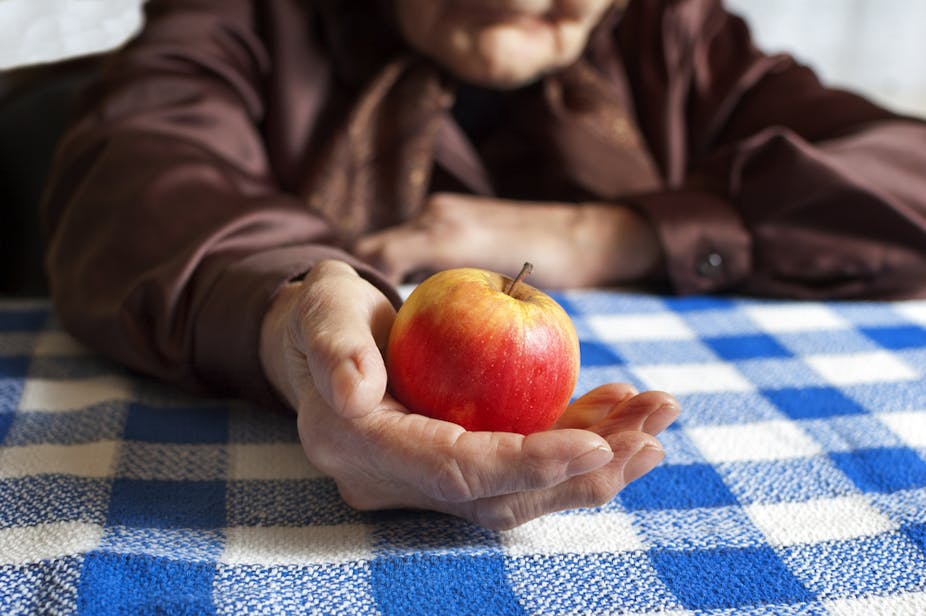The way we interact with objects is based on what we think they are like – their weight, shape and so on. If our expectations are correct, such as knowing that a coffee cup is full, we’ll grasp and lift it with the right amount of force. If not, we might lift too forcefully and spill the coffee down our chin and shirt.

With an object like this – morning coffee in our favourite mug, say – our expectations about its shape and weight are largely based on our memories of using it before.
Many items are less familiar, of course, from utensils and gadgets in the home to novel designs in public places – like those modern taps you never know whether to twist, press or hover. With such objects, our expectations are determined less by our memories and more by what they look like.
If an object appears to be made from a heavy material, we’ll initially lift it with more force than if it looked light. We do the same thing with larger objects compared to smaller ones.
Curiously, our expectations of an object’s properties also influence our perceptions of it once we’ve picked it up – how heavy it feels, say. You may have come across the size-weight illusion, for instance. It demonstrates that when people lift two objects of different sizes but the same weight, most think the smaller object is heavier. While specialists are still debating exactly what is happening to our brains in this situation, suffice to say there is a clear link between what we see and what we experience that can override what our other senses are telling us.
It now turns out that there is a further dimension. I’m part of a research team that has just found that not only do we experience objects partly based on how they look, this changes as we get older. As we shall see, this may have important implications for how we design products in future.
What we did
We recruited 20 older adults with an average age of 71, and 20 younger adults with an average age of 23. We presented each group with black plastic cylinders of different sizes but the same weight.
Each respondent had to say how heavy they thought an object would be, and then how heavy they thought it felt once they had lifted it. We also embedded special sensors on top of each object to measure the grip forces that each person used when grasping and lifting the object (pictured below).

Both groups were equally susceptible to the size-weight illusion, thinking the smaller objects felt heavier than the larger ones. This confirmed that size guides perceptions of weight in younger and older people alike.
But whereas the younger group adjusted the amount of force they used to pick up the cylinders depending on what size they were, the older group did not: they initially gripped and lifted the large and small objects with near-identical force.
What does this mean? One explanation is that to compensate for “normal” age-related decline in physical and cognitive ability, older adults may use mental shortcuts to guide how they act.
They may be redirecting their cognitive resources away from using visual cues to predict an object’s properties towards more demanding aspects of the task, such as having a steady lifting action. There needs to be more research to test this, and also to determine how other visual cues affect how older people interact with them.
To give an example, we know that younger people associate paler materials with lighter weight. Now we need to look into whether the same is true of older people.
Time to redesign?
Numerous previous findings have already shown that older people have difficulties with many product designs. They are not as good at seeing small details; they don’t have as much strength to twist or pull; and cognitive decline can make it harder to deal with complexities like too many buttons or icons.
Toolkits exist online to help designers overcome these problems, though there is a feeling that they are often ignored. Now that our findings are pointing to yet another difference between older and younger people in relation to how they interact with objects, it is one more reason for designers to make their needs a higher priority – particularly given that people are living for longer.
If older people are less good at using an object’s size to help interact with it, for instance, they might be more at risk of applying too much or too little force when using something for the first time: risking spillages, breakages or injuries. It might be even riskier when they’re multi-tasking.

Designs which disguise object properties may therefore present problems for this age group. Designers should be emphasising visual cues that best link to the appropriate action. Transparent saucepans or kettles may make it easier to accurately judge the weight of the pan, for example. Until researchers uncover exactly which visual cues older people respond to best, transparency would at least enable these users to receive the maximum amount of visual information.
The watchword needs to be inclusive designs that everyone can use. That is the best way to enable older people to live independently for as long as possible, not to mention maximising consumer demand for products.

